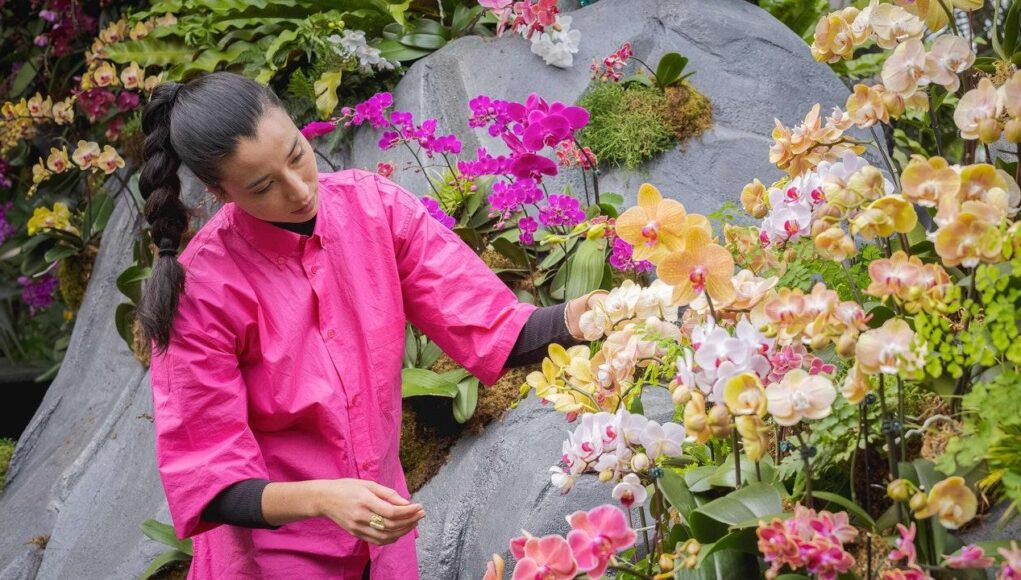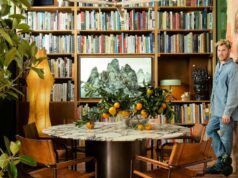When landscape designer and botanical artist Lily Kwong takes on a project, it isn’t necessarily the client who dictates the direction—Mother Nature sets the tone. Kwong, the founder of Freedom Gardens (modeled after the Victory Gardens project during the 1918 pandemic), prefers to replace exotic plants with native ones that assist important species such as bees and butterflies. Her past work has included vivid installations for New York’s High Line and Vanderbilt Hall in Grand Central, but this latest one, as guest designer of the New York Botanical Garden’s 20th anniversary Orchid Show, is already a favorite.
“The Orchid Show: Natural Heritage,” which opens to the public tomorrow, features a range of orchids and Southeast Asian plants that Kwong says she used to “paint, using their subtle differences to create textures and different themes.” For her, it’s never enough to create a landscape that’s simply pretty—though all she touches undoubtedly is. The intention is deeper. With each of her projects, Kwong challenges herself to make a greater ecological and community impact, she says. At the top of her wish list is to integrate native plants into public spaces and transform vacant lots in her current home of Los Angeles into “nourishing plots that can support food access, artistic expression, and community capacitation programs.” Here, Kwong spills on botanical inspiration, her favorite landscape design trend, and more.
AD PRO: Which plant or flower first captured your imagination and planted the seed for this career?
Kwong: The redwood tree. It was the greatest gift of my life to grow up just 10 minutes from Muir Woods. The redwoods are like wise grandparents to me and taught me about the power and magic of the natural world from a very young age.
Is there a landscape design trend you’re seeing emerge of late?
A trend I hope endures forever is I’m seeing more home gardeners prioritize native plants. Native plants are powerful tools for environmental change and urban transformation, and they’re vital to supporting natural ecosystems and critical to regenerating land and climate. Introducing them to public spaces and our own backyards preserves ecological well-being and ensures a more resilient future.
How did you approach The Orchid Show: Natural Heritage, your ecstatic exhibition for the Orchid Show?
This is my most autobiographical piece to date, and it started with me digging into my own family heritage and ancestry as a starting point. The mountainous forms that rise throughout the exhibition are based on four large scrolls that were passed down to me from my grandparents from Shanghai. They loomed large on my living room wall throughout my entire childhood and captured my imagination. Through additional research on Chinese landscape paintings we created this mythical landscape that transports viewers back to a moment in time where humans and nature coexisted peacefully.
Do you have a favorite moment in the show?
The meditative walkway that draws on principles of traditional Chinese garden design and integrates sculptural rocks into undulating water features. Each rock features species or varieties of Chinese native orchids prized for their healing properties in Chinese traditional medicine. I loved learning how these orchids are carriers of rich cultural information, and the dendrobiums featured in some of these vignettes are lithophytic, meaning they grow on rocks. Many are prized for exactly this reason: They are considered an embodiment of strength and often administered to boost longevity and chi, vital life force energy.
What small landscaping move do you feel can make a significant impact?
Avoiding perfect symmetry and approaching landscaping from a biomimicry perspective is something that has intuitively always felt right. It can seem subtle but always seems to have such a big impact. Nature can be our greatest teacher, so I often spend a long time observing the natural habitat when working on a new project, especially in a new region.
What plant do you feel brings the most personality to a space?
A horticulturist once told me that grasses bring the emotion to a garden. That always stuck with me and taught me how important it is to tell stories with your plant selection, whether it’s a character specimen tree or a specific color palette.
What is your favorite way to bring the outdoors inside?
Plants are an obvious choice, but recently I’ve loved integrating rocks or vessels made out of earth into the home as a deeply grounding element.
What do you think everyone should start planting this year?
Food! Growing edibles has been so rewarding. I started my own personal edible garden during the lockdown and have learned so much about a plant’s life cycle since. It feels empowering to reconnect to where food comes from and gain agency over our food sources.








